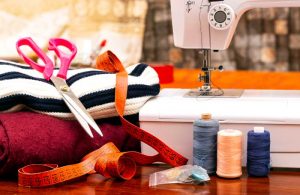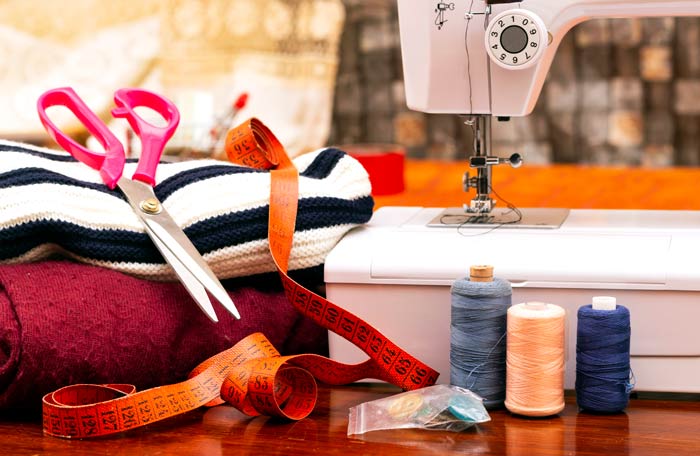Is your sewing project plagued by unstable seams, puckering, or just unappealing stitching? The chances are that there might be a problem with the bobbin tension.
 Sewing tension problems can be caused by improper top or bottom thread tension because they are produced by an inconsistency in the pressure on the two pieces of thread.
Sewing tension problems can be caused by improper top or bottom thread tension because they are produced by an inconsistency in the pressure on the two pieces of thread.
It’s possible that the stitches are too slack or don’t form correctly. The lower thread, or bobbin thread, tension is generally adjusted by a screw on the bobbin case.
Before you start opening up your sewing machine and getting all down and dirty, I would recommend checking other areas first.
When resolving your favorite Brother sewing machine tension difficulties, as a tenderfoot, it may be a challenging predicament to be in.
Do not worry, though, because I have the most straightforward and simple guide to help you resolve this problem and adjust the bobbin tension on the brother sewing machine.
How to adjust Bobbin tension on Brother Sewing Machine?
If required, the bobbin case mounted in this machine may be changed to suit the bobbin tension for embroidering. However, modify the bobbin tension only as of the last option, provided you know what you’re doing.
The majority of sewing machine tension issues are caused by the top thread, needle, stitch setting, bobbin installation, etc.
Therefore you will be checking some things before you start tinkering with the tension as per the guide. Since, oftentimes, it turns out to be something different!
Therefore in the first few steps, I will be telling you how to check if the problem you are facing is, in fact, as you suspected, and the bobbin tension needs to be adjusted.
If you need to alter the bobbin tension, follow the steps below.
Step 1: Make sure your sewing machine is accurately threaded
Many tension problems develop as a result of improperly threaded Sewing machinery. This error generally occurs when sewer threads with the presser foot down, preventing the thread from sliding all the way between the tension discs.
To begin, ensure that the thread from the bobbin follows all of the thread guidelines as specified in your sewing machine handbook. Brother sewing machines are among the best sewing machine brands available.
If you ever have tension issues, always examine your handbook to see if there are any instructions for dealing with it. Furthermore, be certain that the sewing machine is threaded with the presser foot up.
If you even have the slightest of doubts rethread, while making sure that the presser foot is elevated.
Step 2: Double-check bobbin installation
Check that the bobbin is oriented correctly and that it is not wound excessively loosely, firmly, or unevenly. Also, while you’re looking at your bobbin, make sure the space around it is clean and lint-free.
If it isn’t, clean it out. Sewers who sew frequently should clean their sewing machines at least once a week. This removes lint and crud that would otherwise be trapped between the tension discs.
To avoid tension problems, keep your Brother sewing machine lint-free at all times as a sewing machine that hasn’t been cleaned in a long time will almost definitely cause difficulties.
Step 3: Ensure that the correct needle size is utilized
If your needle is not the correct size for the job, it can easily influence the tension of your machine. Check to see whether your needle is broken.
Selecting the proper needle size is critical for a successful sewing job. Using a crooked or dull needle might also cause sewing problems.
Verify that you’ve chosen a needle that is compatible with your project and isn’t broken or the wrong size.
Step 4: Determine the thread weight
If you use the wrong thread size, your tension settings will be a problem. If you’re experiencing unexpected problems, make sure the top and bottom threads are equivalent in terms of size.
Step 5: Verify that you have the appropriate stitch setting
It is not necessary that the problem you are facing is in the bobbin tension. Some stitches and fabrics don’t work together.
Check the stitch settings of your sewing machine as well as the type of stitch to determine if the problem lies there. You can make a bit of trial and error and try to change the type of stitch to see if the problem still remains.
Step 6: Use a screwdriver to adjust the bobbin case tension
For this step, you will need a small size notched screwdriver. Use the screwdriver to adjust the bobbin case tension. For this, you need to take caution and ensure that you turn only the slotted head which has a tiny dash on its head.
Be careful not to accidentally turn the Phillips screw which has a positive sign on its head. While resetting the bobbin case, make sure the bobbin is taken out from the bobbin case.
You must not meddle with the Phillips screw on the bobbin case, as this could lead to damage to the bobbin case, making it unusable. When turning the slotted-head screw, do not apply force if it is difficult.
Turning the screw too far or applying too much power in whichever (rotational) direction could result in damage to the bobbin case.
Step 7: Check the upper thread
Next, you need to check if the thread tension is in its correct position. You will be able to identify this by seeing if the upper thread looks like it’s slightly on the wrong side of the fabric.
If that is the case, there is no issue with the bobbin tension.
However, if it appears as if the upper thread which is present on the right side of the fabric is either lifted or looped or the bobbin thread is not in the correct position as described before, then you will need to turn the slotted head screw.
Step 8: Turn the slotted head screw if the thread is on the right side
If the thread tension and upper thread are on the right side of the fabric, you will need to turn the notched head screw in a counterclockwise direction as the bobbin tension is too tight.
Take care not to loosen up the screw too much as that could lead to more problems. For a guide turning the screw at an angle of 30-45 degrees is sufficient to decrease the bobbin tension.
Step 9: Tighten the screw if the bobbin thread is on the right side
You might have also come across a scenario where the bobbin thread is not in its correct position and tilts towards the right side of your sewing machine.
This probably means that the bobbin tension is too loose. To fix this problem, you will have to turn the slotted head screw in a clockwise direction with a screwdriver.
Again you need to be careful not to over-tighten the screw, so do not turn the screw at an angle for more than 30 to 34 degrees.
Frequently Asked Questions
How do I adjust the tension on my brother’s bobbin?
You will need to figure out first whether the tension is too tight or loose first. After taking out the bobbin’s case, turn the screw in an anti-clockwise or clockwise direction depending on how you want to adjust it.
What tension should my brother’s sewing machine be set at?
The tension dial of your sewing machine should be set up between the range of 2 and
How do I tighten my bobbin tension?
You will need to turn the notched screw counterclockwise to tighten the tension. If you need to loosen the bobbin tensions, then use a screwdriver to turn it clockwise.
What should sewing machine tension be set at?
The normal position is set at 4.5. It would help if you went for a setting between 2 to 6.
How do I reset the tension on my Brother’s sewing machine?
Reduce the thread tension slider to a lower setting when the top thread is exposed from the fabric’s bottom side. Increase the thread tension slider to a higher setting.
How do I know if my bobbin tension is correct?
Your bobbin tension is too free if the thread unwinds without effort and the casing falls to the floor. If the bobbin case would not move, your bobbin tension is too high.
It is possible that you still have some questions regarding adjusting the bobbin tension of your Brother sewing machine.
Here are the answers to some frequently asked questions that may be able to clear out any remaining queries that you might have.
Conclusion
Don’t be overwhelmed if you are new to this, as adjusting the tension of sewing machines is a problem that many beginners and even experts have trouble with.
Just remember not to panic and open the bobbins case only as your last resort. I hope you found the step to step guide helpful, and it fixed all of the problems you were facing.

